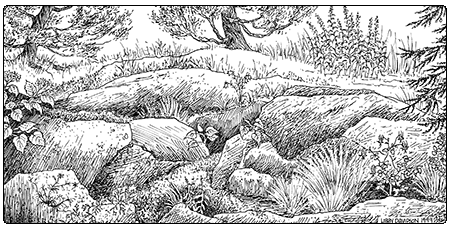Ecology and Physical Setting 
These outcrops are found in the warmer regions of the state, on summits and other natural openings on calcareous bedrock such as limestone, dolostone, marble, or calcareous schist, usually below 2,000 feet elevation. Some of these rock types are susceptible to weathering and so can develop deep fissures where water seeps into cracks, enlarging them over millennia. These fissures add to the overall droughtiness of these areas, draining water away very quickly. Weathering also releases nutrients held in the calcareous bedrock. Thus, lime-loving plants characterize these outcrops.
Vegetation

plant of dry rocky openings.
Temperate Calcareous Outcrops are patchworks of bare rock and soil pockets that support a diverse array of calcium-loving plants. In some cases, they are dominated by grasses, sedges, and bryophytes; in other cases, they are shrub-dominated. Still other outcrops have little vegetation, and herbs may dominate locally. There are often scattered trees, but as on all outcrop communities, they are stressed by periodic drought and do not reach great size. Some characteristic species include northern white cedar, yellow oak, snowberry, downy arrowwood, pasture rose, smooth shadbush, ebony spleenwort, Kalm’s brome grass, and ebony sedge. Like other natural calcareous openings, this community supports an unusually high number of rare plants.
Wildlife Habitat
Temperate Calcareous Outcrops are typically found as small forest openings or on cliff tops, and the wildlife present is most associated with the adjacent forest. Several reptiles, including DeKay’s brownsnake and the rare eastern ratsnake and five-lined skink, are known to use these sun-warmed outcrops for basking. Chipping sparrows forage in the openings and nest in stunted trees in the outcrop, or in trees or shrubs at the forest edge.
Related Communities
- Temperate Calcareous Cliff shares many species in common with Temperate Calcareous Outcrop but has slopes greater than 60 degrees.
- Temperate Acidic Outcrop shares some species and many ecological processes with Temperate Calcareous Outcrop, but species diversity is lower and calcium-dependent plants are absent. There are intermediates between the two, on neutral to slightly acidic bedrock.
- Red Cedar Woodland often interfingers with open outcrops.
Conservation Status and Management Considerations
Temperate Calcareous Outcrop is an uncommon community in Vermont. Throughout New England and New York, low and mid-elevation calcareous bedrock is rare, so our outcrops are of regional conservation value. A number of high quality examples of Temperate Calcareous Outcrop are on conserved lands in Vermont, but additional examples should be sought for protection.
These outcrops can offer expansive views and can be popular places to visit. Visitors should use care to avoid trampling the vegetation.
Distribution/Abundance
This community is known from the Champlain Valley, Vermont Valley, and Taconic Mountains biophysical regions. An outlying example is known from the Southern Green Mountains. These outcrops are regionally uncommon.
Characteristic Plants
Trees
White ash – Fraxinus americana
Eastern red cedar – Juniperus virginiana
Northern white cedar – Thuja occidentalis
Red oak – Quercus rubra
White oak – Quercus alba
Yellow oak – Quercus muehlenbergii
Shagbark hickory – Carya ovata
Hophornbeam – Ostrya virginiana
Shrubs
Downy arrowwood – Viburnum rafinesquianum
Pasture rose – Rosa carolina
Shrubby cinquefoil – Dasiphora fruticosa
Smooth shadbush – Amelanchier laevis
Snowberry – Symphoricarpos albus
New Jersey tea – Ceanothus americanus
Herbs
Cow-wheat – Melampyrum lineare
Ebony spleenwort – Asplenium platyneuron
Rock sandwort – Minuartia michauxii
Little bluestem – Schizachyrium scoparium
Ebony sedge – Carex eburnea
Woodland sedge – Carex pensylvanica
Common pinweed – Lechea intermedia
Woodland sunflower – Helianthus divaricatus
Poverty grass – Danthonia spicata
Wild columbine – Aquilegia canadensis
Field chickweed – Cerastium arvense
Balsam ragwort – Packera paupercula
Four-leaved milkweed – Asclepias quadrifolia
Non-native Plants
Canada bluegrass – Poa compressa
Rare and Uncommon Plants
Richardson’s sedge – Carex richardsonii
Hairy honeysuckle – Lonicera hirsuta
Lyre-leaved rock cress – Arabidopsis lyrata
Creeping juniper – Juniperus horizontalis
Purple clematis – Clematis occidentalis
Snowy aster – Solidago ptarmicoides
Bronze sedge – Carex foenea
Smooth false-foxglove – Aureolaria flava
Harsh sunflower – Helianthus strumosus
Downy arrowwood – Viburnum rafinesquianum
Hairy beardtongue – Penstemon hirsutus
Yellow oak – Quercus muehlenbergii
Fragrant sumac – Rhus aromatica
Canada buffaloberry – Shepherdia canadensis
Golden corydalis – Corydalis aurea
Hoary whitlow-grass – Draba cana
Longleaf bluet – Houstonia longifolia
Spring forget-me-not – Myosotis verna
Wiry witchgrass – Panicum flexile
Prickly rose – Rosa acicularis
Rough dropseed – Sporobolus compositus
Biltmore hawthorn – Crataegus biltmoreana
Seneca snakeroot – Polygala senega
Kalm’s brome grass – Bromus kalmii
Rock spike-moss – Selaginella rupestris
Associated Animals
DeKay’s brownsnake – Storeria dekayi
Chipping sparrow – Spizella passerina
Rare and Uncommon Animals
Eastern ratsnake – Pantherophis alleghaniensis
Common five-lined skink – Plestiodon fasciatus
Columbine duskywing – Erynnis lucilius
Places to Visit
Shaw Mountain Natural Area, Benson, The Nature Conservancy
Pease Mountain, Charlotte, University of Vermont Natural Area
Button Bay State Park, Ferrisburgh, Vermont Department of Forests, Parks, and Recreation
